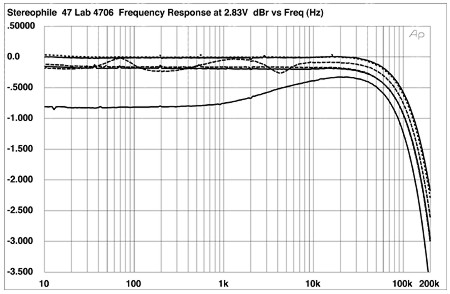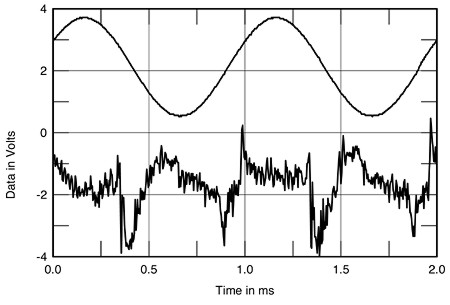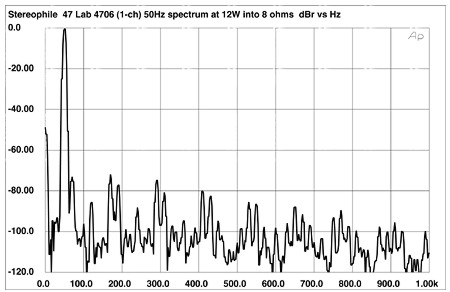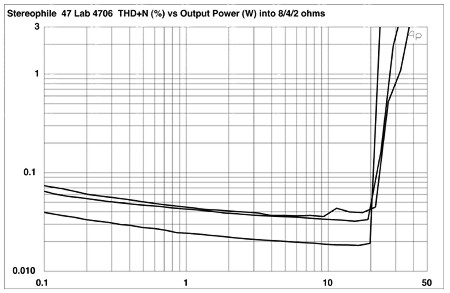| Columns Retired Columns & Blogs |
47 Laboratory 4706 Gaincard power amplifier Measurements
Sidebar 3: Measurements
After the usual one-hour preconditioning period at 1/3 power into 8 ohms, the tiny 47 Lab 4706 Gaincard amplifier was far too hot to touch. It was so hot, in fact, that I was alarmed that something might have broken. Fortunately, everything was fine, but owners should be sure to give the 4706 plenty of room for adequate ventilation.
Looking first at the basics, the Gaincard didn't invert signal polarity. Its maximum gain into 8 ohms was a moderate (for an integrated amplifier) but adequate 30.4dB. The input impedance (measured at 1kHz) depended on the volume-control setting; it was a fairly high 35.6k ohms at 12:00 o'clock, dropping to 14.3k ohms at the maximum settings. As RD noted, the steps between the control settings were large: 8.2dB for the first from the top, with then 3.5dB steps down to 11:00, followed by 5dB steps below that level. Setting an optimal volume setting is going to be a hit-or-miss affair.
Fig.1 shows the 4706's frequency response into a variety of resistive loads, as well as into Stereophile's simulated loudspeaker load. The drop in level between the 8 and 4 ohm conditions was small, as were the variations into the simulated speaker, implying a low source impedance. I measured around 0.15 ohm at 20Hz and 1kHz, this dropping to 0.08 ohm at 20kHz. Into 2 ohms (bottom trace, fig.1) there was a much larger response change than I would have anticipated from the low source impedance. In addition, a broad peak appears in the high treble. There was no change in high-frequency rolloff at different volume-control settings, the wide-bandwidth output remaining about 1.75dB down at 200kHz.

Fig.1 47 Lab 4706 Gaincard, frequency response with one channel driven at a time at (from top to bottom at 2kHz): 1W into 8 ohms, 2.83V into dummy loudspeaker load, 2W into 4 ohms, 4W into 2 ohms (right channel dashed, 0.5dB/vertical div.).
This graph was measured with each channel driven separately. By chance, I repeated a response measurement with the left channel loaded by 2 ohms, the right with the dummy load. Much to my surprise, the result (fig.2) was quite different from the behavior with one channel driven at a time. The response fluctuations with the dummy load (dashed trace) were higher; in addition, those response changes were mirrored in the 2 ohm response (solid trace).

Fig.2 47 Lab 4706 Gaincard, frequency response with both channels driven simultaneously at 2.83V into dummy loudspeaker load (solid) and 4W into 2 ohms (dashed). (0.5dB/vertical div.)
Although the amplifier's negative feedback loop reduces its apparent output impedance, the Humpty power supply (and its thin supply cables) must have an intrinsically high source impedance. Asking it to deliver much in the way of current to one channel, therefore, apparently starts to starve the other channel of current. This can be seen in the channel-separation graph (fig.3), which I deliberately took at a high level (10V RMS) into 8 ohms. Despite the physical separation of the modules for each amplifier channel, the crosstalk is a very high -36dB below 1kHz, dropping to a still poor but probably adequate -48dB at 20kHz.

Fig.3 47 Lab 4706 Gaincard, channel separation (10dB/vertical div., R-L dashed).
The amplifier's squarewave responses, however, were excellent. The 10kHz response (fig.4) has a very good shape, with short risetimes; the 1kHz waveform (not shown) was essentially perfect. Neither waveform showed any indication of instability.

Fig.4 47 Lab 4706 Gaincard, small-signal 10kHz squarewave into 8 ohms.
The 4706 has low harmonic distortion in the midband, even into low impedances. This can be seen in fig.5: the measured THD drops to almost 0.01% into 16 ohms (bottom trace), and is still only just above 0.04% into 2 ohms. However, the THD rises quite dramatically at both high and low frequencies. The former will be due to the circuit's limited open-loop bandwidth, which reduces the amount of corrective feedback available as the frequency increases; the latter is presumably due, again, to the Humpty's limitations with respect to current delivery, which appear to be greater at low frequencies.

Fig.5 47 Lab 4706 Gaincard, THD+noise (%) vs frequency at (from top to bottom at 10kHz): 4W into 2 ohms, 2W into 4 ohms, 1W into 8 ohms, 2.83V into simulated loudspeaker load, 0.5W into 16 ohms (right channel dashed).
The lower trace in fig.6 is a snapshot of the 1kHz distortion+noise waveform at a high level into 4 ohms. Even close to clipping, and with the noise reduced by around 15dB by averaging 32 traces, the distortion waveform is dominated by noise—the measured figure for both was 0.024%. But the main character can be seen to be the second harmonic at twice the signal frequency, which is good. What is less good are the spikes overlaying the waveform at the signal's zero-crossing points, which imply inadequate standing bias current in the Gaincard's output stage. When RD writes about "a hardness or glare in the upper midrange and treble," I do wonder if that correlates with the presence of the high-order harmonics that will result from this behavior. Of course, RD also found that this character dissipated after a very long break-in period.

Fig.6 47 Lab 4706 Gaincard, 1kHz waveform at 22W into 4 ohms (top), distortion and noise waveform with fundamental notched out (bottom, not to scale).
Fig.7 shows another way of looking at the distortion in the 4706's output: in the frequency domain. This time, I drove a bass tone at half power into 8 ohms. Looking at the spectrum, the second harmonic does indeed make an appearance, but at -94dB (0.002%), it will have zero effect on the amplifier's perceived sound quality. Some power-supply-related spuriae can be seen at 60Hz and 120Hz, and again at -76dB (0.015%) and -86dB (0.005%), but these will be inaudible. (These increased in level when I grounded the negative speaker terminal, so I left the amplifier's output floating for these measurements.)

Fig.7 47 Lab 4706 Gaincard, spectrum of 50Hz sinewave, DC-1kHz, at 12W into 8 ohms, one channel driven (linear frequency scale).
What does bother me in this graph are the strange pairs of peaks that regularly decrease with increasing frequency. The first pair have frequencies of exactly 170Hz and 190Hz (ie, 180Hz ±10Hz); the second pair, 300Hz ±10Hz; the third pair, 420Hz ±10Hz; and the fourth pair, 540Hz ±10Hz. These frequencies are suspicious in that they are exactly the third, fifth, seventh, and ninth harmonics of the AC power-supply frequency. Even more suspicious is the fact that the modulating frequency is identical to the difference between the AC supply and the signal frequencies. The finger must again be pointed at the Humpty power supply as having too high a source impedance at low frequencies.
Fig.7 was taken with one channel driven. To confirm my suspicions, I repeated the spectral analysis with both channels driven, with the power level kept the same: 12Wpc into 8 ohms. The result is shown in fig.8—all the power-supply-related spuriae have risen, in some cases by as much as 10dB! Repeating the measurement with one channel driven but doubling the output current by dropping the resistive load to 4 ohms gave an identical-looking spectrum (not shown).

Fig.8 47 Lab 4706 Gaincard, spectrum of 50Hz sinewave, DC-1kHz, at 12W into 8 ohms, two channels driven (linear frequency scale).
On the bright side, the Gaincard's intermodulation distortion was very low, even at levels close to clipping into low impedances. Fig.9, for example, shows the spectrum of an equal sum of 19kHz and 20kHz tones at an indicated 15.2W into 4 ohms—just below visible clipping on the oscilloscope screen with this waveform. The 1kHz difference component lies at a superb -94dB (0.002%), and the second-order components either side of the main tones are not much higher in level.

Fig.9 47 Lab 4706 Gaincard, HF intermodulation spectrum, DC-24kHz, 19+20kHz at 15.2W into 4 ohms (linear frequency scale).
With both channels driven continuously, the Gaincard couldn't quite meet its specified output power at the traditional 1% THD limit (fig.10), with 22Wpc available into 8 ohms (13.4dBW) and 27.5Wpc into 4 ohms (11.4dBW). However, using the Miller Audio Research Amplifier Profiler to drive just one channel of the amplifier with a low-duty-cycle 1kHz toneburst indicated that more power was available with this music-like signal (fig.11): 26.5W into 8 ohms (14.2dBW, black trace) and 38.7W into 4 ohms (12.9dBW, red trace). Note the jagged edges of these traces close to clipping; the amplifier actually seems to stabilize two or three times at high power levels before clipping for real. This is not apparent into lower impedances (blue and green traces), but the amplifier more or less reaches its current limit below 4 ohms, with no more power available into 2 ohms than into 4 ohms and only half the 4 ohm power available into 1 ohm. (This, by the way, is equivalent to a maximum output current of 4.5A.)

Fig.10 47 Lab 4706 Gaincard, distortion (%) vs continuous output power into (from bottom to top at 1W): 8 ohms, 4 ohms, 2 ohms.

Fig.11 47 Lab 4706 Gaincard, distortion (%) vs 1kHz burst output power into 8 ohms (black trace), 4 ohms (red), 2 ohms (blue), and 1 ohm (green).
In some areas—the lack of intermodulation distortion, the superb squarewave performance, the wide bandwidth—the 4706 Gaincard offered excellent measured performance. In fact, almost all the measured problems I encountered can be laid at the feet of the Humpty power supply. Given the very high sensitivity of Robert Deutsch's Avantgarde speakers and the fact that they use powered woofers, it's possible that these problems didn't impinge on his auditioning. It should also be noted that the negative effects of the Humpty power supply's current-delivery problems would be eliminated were each channel of the Gaincard driven by its own supply. However, this would add $1800 to the amplifier's cost, which makes the package seem expensive for just 25Wpc.—John Atkinson
- Log in or register to post comments




































